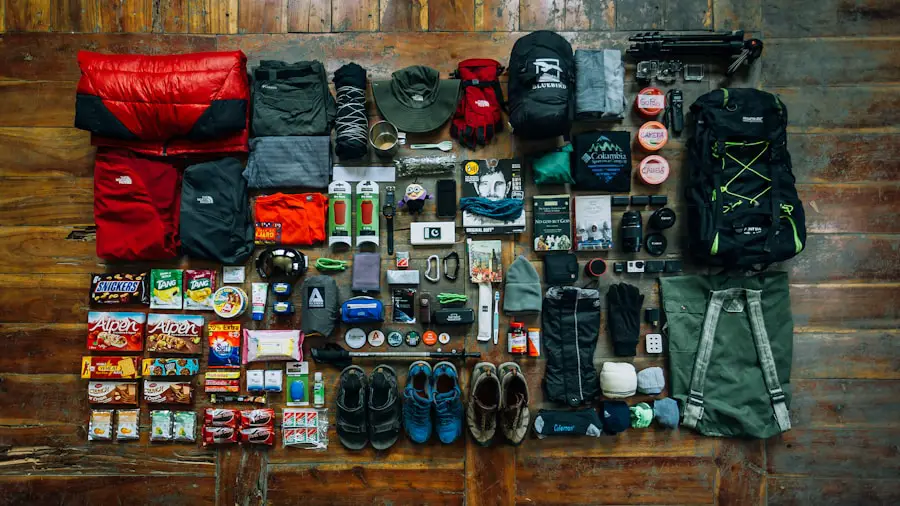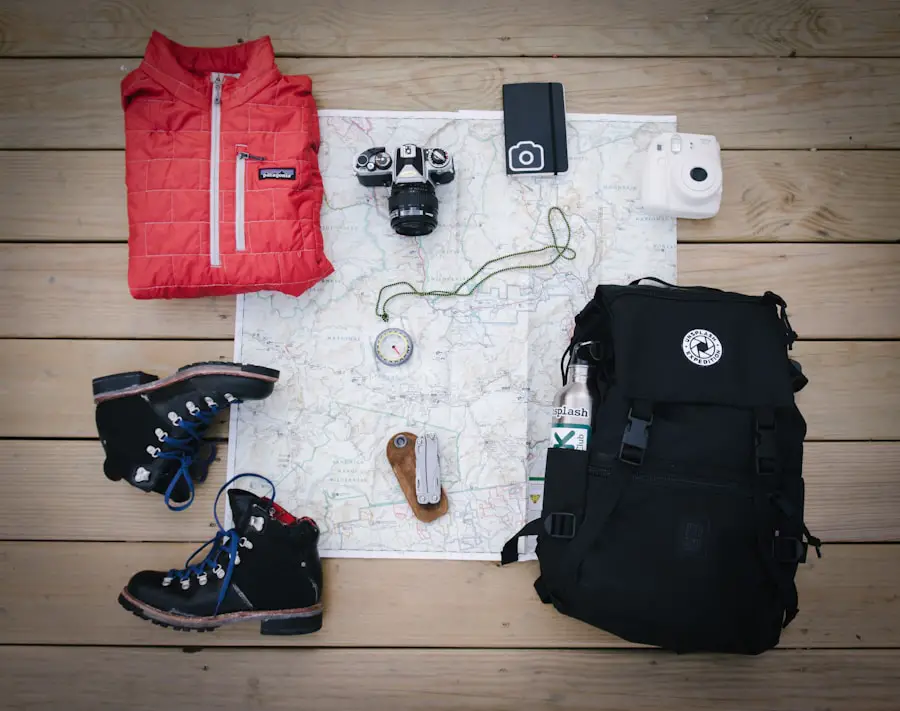Selecting the appropriate footwear is one of the most critical decisions a hiker can make. The right hiking boots or shoes can significantly enhance comfort, stability, and overall performance on the trail. When considering footwear, it is essential to evaluate the type of terrain you will encounter.
For instance, rugged trails with rocky surfaces may require boots with a stiffer sole and more aggressive tread patterns to provide traction and support. Conversely, if you plan to hike on well-maintained paths, lightweight trail runners or hiking shoes may suffice, offering breathability and flexibility. Fit is another paramount factor in choosing hiking footwear.
A proper fit ensures that your feet remain comfortable over long distances and helps prevent blisters and other foot ailments. When trying on boots or shoes, it is advisable to wear the same type of socks you plan to use on your hike. Additionally, consider the time of day when trying on footwear; feet tend to swell throughout the day, so trying them on in the afternoon can help you find a more accurate fit.
Look for a snug fit around the heel and midfoot while allowing enough room in the toe box for your toes to wiggle. This balance is crucial for maintaining comfort during extended hikes.
Key Takeaways
- Choose hiking boots or shoes that are comfortable, provide good ankle support, and are suitable for the terrain you will be hiking on.
- Layer your clothing for comfort and protection, including a moisture-wicking base layer, insulating mid-layer, and waterproof outer layer.
- Bring maps, a compass, and GPS devices to ensure you can navigate the trail safely and accurately.
- Protect yourself from the sun with sunscreen, sunglasses, and a hat to prevent sunburn and eye damage.
- Stay hydrated on the trail with water bottles, hydration packs, and water purification methods to ensure clean drinking water.
Clothing: Layering for Comfort and Protection
The clothing you choose for hiking plays a vital role in your overall comfort and protection from the elements. Layering is a fundamental principle that allows hikers to adapt to changing weather conditions effectively. The three primary layers consist of a base layer, an insulating layer, and an outer shell.
The base layer, typically made from moisture-wicking materials like merino wool or synthetic fabrics, helps keep sweat away from your skin, which is essential for maintaining body temperature during physical exertion. The insulating layer serves to trap heat and provide warmth when temperatures drop. Fleece jackets or down vests are popular choices for this layer, as they offer excellent insulation without adding excessive bulk.
The outer shell, often made from waterproof or windproof materials, protects against rain, snow, and wind. It is crucial to select a shell that is breathable to prevent overheating during vigorous activity. By utilizing this layering system, hikers can easily adjust their clothing based on their activity level and the weather conditions they encounter.
Navigation: Maps, Compass, and GPS Devices

Navigating through the wilderness requires a solid understanding of various tools and techniques. Traditional maps and compasses remain invaluable resources for hikers who wish to develop their navigation skills. A topographic map provides detailed information about the terrain, including elevation changes, water sources, and trails.
Learning how to read these maps is essential; understanding contour lines can help hikers gauge the steepness of a trail and plan their route accordingly. In addition to maps and compasses, GPS devices have become increasingly popular among hikers for their convenience and accuracy. Handheld GPS units can provide real-time location data, making it easier to stay on course.
However, reliance solely on technology can be risky; batteries can die, and signals can be lost in remote areas. Therefore, it is wise to carry both traditional navigation tools and electronic devices. Familiarizing yourself with how to use a compass in conjunction with a map can be a lifesaver if technology fails.
Sun Protection: Sunscreen, Sunglasses, and Hats
| Category | Statistic |
|---|---|
| Sunscreen | Only 30% of Americans regularly apply sunscreen |
| Sunglasses | 75% of adults report wearing sunglasses in the past year |
| Hats | 40% of Americans report wearing a hat for sun protection |
When spending extended periods outdoors, sun protection is paramount to prevent skin damage and heat-related illnesses. Sunscreen should be a staple in every hiker’s pack; it is essential to choose a broad-spectrum sunscreen with an SPF of at least 30. Apply it generously to all exposed skin at least 15 minutes before heading out and reapply every two hours or after swimming or sweating heavily.
Pay special attention to areas often overlooked, such as the ears, back of the neck, and tops of the feet. In addition to sunscreen, wearing protective clothing can further shield you from harmful UV rays. A wide-brimmed hat not only provides shade for your face but also helps keep you cool by blocking direct sunlight.
Sunglasses with UV protection are equally important; they protect your eyes from glare and long-term damage caused by sun exposure. Opt for sunglasses that wrap around your face for maximum coverage and comfort during your hike.
Hydration: Water Bottles, Hydration Packs, and Water Purification
Staying hydrated is crucial for maintaining energy levels and overall health while hiking. Carrying an adequate supply of water is essential, whether you opt for traditional water bottles or hydration packs. Water bottles are versatile and easy to refill but can be cumbersome to carry on long hikes.
Hydration packs offer a convenient solution; they allow you to sip water through a tube without stopping frequently. Many packs also come with additional storage for snacks or small gear. In areas where water sources are available, it is vital to have a plan for purifying water before consumption.
Water purification methods include filters, chemical treatments like iodine tablets, or UV light devices that kill harmful pathogens. Each method has its pros and cons; filters are effective but can be bulky, while chemical treatments are lightweight but require waiting time before drinking. Understanding the water sources along your route and preparing accordingly will ensure you remain hydrated throughout your hike.
Nutrition: Trail Snacks and Meals for Energy

Proper nutrition is essential for sustaining energy levels during hikes, especially on longer treks where physical exertion can lead to fatigue. Packing nutritious trail snacks can help maintain energy levels between meals. High-energy foods such as nuts, dried fruits, energy bars, and jerky are excellent choices due to their compact size and high caloric content.
These snacks provide quick energy boosts without weighing down your pack. For longer hikes that extend over several hours or even days, planning meals becomes crucial. Lightweight options like dehydrated meals or freeze-dried foods are popular among backpackers because they are easy to prepare—just add hot water—and provide balanced nutrition.
Additionally, consider packing items like whole-grain wraps filled with nut butter or hummus and vegetables for a more substantial meal on the go. Balancing carbohydrates, proteins, and fats will help sustain energy levels throughout your adventure.
First Aid Kit: Essential Items for Treating Injuries on the Trail
A well-stocked first aid kit is an indispensable part of any hiking gear list. Accidents can happen even on well-trodden paths; therefore, being prepared can make all the difference in treating minor injuries effectively. Essential items in a first aid kit should include adhesive bandages in various sizes for cuts and blisters, antiseptic wipes for cleaning wounds, gauze pads for larger injuries, and medical tape for securing dressings.
In addition to basic supplies, consider including items specific to your needs or those of your hiking companions. For example, if someone in your group has allergies, carrying antihistamines can be crucial in case of an allergic reaction. A pair of tweezers can help remove splinters or ticks, while pain relievers like ibuprofen or acetaminophen can alleviate discomfort from strains or headaches.
Familiarizing yourself with how to use each item in your first aid kit will ensure you are prepared to handle emergencies effectively.
Emergency Supplies: Whistle, Fire Starter, and Shelter Options
In addition to first aid supplies, carrying emergency gear can be vital in unexpected situations while hiking. A whistle is an essential item that can signal for help if you become lost or injured; its sound carries much farther than a human voice and requires less energy to use than shouting. A whistle should be easily accessible—consider attaching it to your backpack or wearing it around your neck.
Fire starters are another critical component of emergency supplies; they can provide warmth and a means of cooking food if you find yourself stranded overnight. Options include waterproof matches, lighters, or fire starter kits that use magnesium or other materials designed to ignite easily even in wet conditions. Additionally, having a lightweight emergency shelter such as a space blanket or bivy sack can protect you from the elements if you need to spend an unplanned night outdoors.
These supplies not only enhance safety but also provide peace of mind as you explore the great outdoors.
If you are planning a hiking trip, it is important to have the necessary gear and equipment. One essential item to consider is a solar-powered camping lantern, which can provide light during your outdoor adventures. This article on solar-powered camping lanterns offers valuable information on the best options available in the market. Having a reliable source of light can make a significant difference in your hiking experience, especially during the night or in low-light conditions.
Love travel? Join Our Facebook Community For More Tips.
FAQs
What are the ten essentials for hiking?
The ten essentials for hiking are a list of items that are recommended to bring on every hike to ensure safety and preparedness in the outdoors.
What are the ten essential items for hiking?
The ten essential items for hiking include navigation tools (map and compass), sun protection (sunglasses and sunscreen), insulation (extra clothing), illumination (headlamp/flashlight), first-aid supplies, fire (waterproof matches/lighter), repair kit and tools, nutrition (extra food), hydration (extra water), and emergency shelter.
Why are the ten essentials important for hiking?
The ten essentials are important for hiking because they help hikers be prepared for unexpected situations and emergencies that may arise while on the trail.
Are the ten essentials for hiking the same for all types of hikes?
The basic ten essentials for hiking remain the same for all types of hikes, but additional items may be necessary for more challenging or remote hikes.
Where can I find a checklist for the ten essentials for hiking?
Checklists for the ten essentials for hiking can be found online through outdoor retailers, hiking organizations, and government agencies such as the National Park Service or the American Hiking Society.
